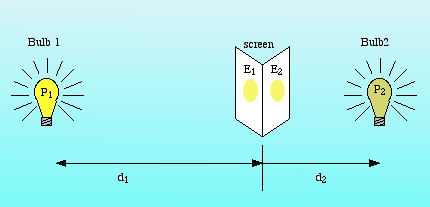| ERHS PHYSICS
Chapter 16.1 Notes LIGHT |
 |
|
| ERHS PHYSICS
Chapter 16.1 Notes LIGHT |
 |
|
Light generally refers to that portion of the electromagnetic spectrum that we can see, and has wavelengths of approximately 400 nanometers (violet) through 700 nanometers (red). We sometimes also include the wavelengths of light just at the fringes of these, infrared and ultraviolet light. Some living organisms are sensitive in different ways to ultraviolet and infrared light. While we cannot percieve them visually, we are sensitive in other ways. For example, our perception of infrared is as heat or warmth. The pit vipers, however, have special organs in their snouts that allow them to follow the infrared "signature" of small mammals in complete darkness. Light itself has no color. Color is rather, the mental perception of specific wavelengths of visible light. This perception is dependent upon the physiology of the rod and cone cells of the eye and the neural processing of waves that stimulate those cells. If there is no brain, there is no color!
Look here for more information on Color and Spectrum.
Light, like other electromagnetic energy travels through a vacuum at 3.0 x 108 m/s, (actually 2,99,792,458 m/s)
You Try: do the practice problems 1-4 page 376
Online resource on the Electromagnetic Spectrum: http://imagine.gsfc.nasa.gov/docs/science/know_l1/emspectrum.html
Sources of light:
Objects are visible to us because light comes to our eyes from them. Visible objects fall into two categories:
Bodies that EMIT light, in otherwords that actually produce the light, are said to be luminous. Such objects can be luminous because they are hot (incandescent), because they give off photons when bombarded with other em energy (flourescent), or because they are living organisms that give off photons as a result of biochemical activity (bioluminescent).
Examples:
Objects that are visible not because they are sources of light, but because they REFLECT light from other sources are said to be illuminated rather than luminous.
Measuring light (Photometry)
Light is energy carried in an electromagnetic wave that is made to vibrate by electric charges in the atom. When light is shined on an object, the electric charges (think of electrons) are forced into vibration. (This is similar to the way sound waves forces the molecules in an object to vibrate as sound is transmitted by a mechanical wave.)
The rate at which light is emitted from a source is luminous flux, P. The unit of luminous flux is the lumen (lm); it refers to the total of all the light emitted, in all directions. If you look at the package that light bulbs come in, they usually give the flux for that bulb. Typically, a 100-watt bulb emits about 1750 lumens of light.
Now.. the luminous flux of a source is usually leaving the source, radiating out in all directions, and not ALL that flux falls on any one object. The amount of light that actually does land on a particular object is called illuminance, E. You would be interested in this value when you read, for example, because you need to have a specific amount of light on your book, regardless of how much leaves the lamp! If we're interested only in the amount of light incident on a surface, such as a book or sheet of paper we use the term illuminance, E. Illuminance is measured in lumens per square meter or lm/m2 or lux (lx). The illuminance directly under a small light source, is given by
![]()
Where E is illuminance, P is luminious flux (in lumens) and d is the distance between the source and the illuminated object. You may have a video camera at home, if you do, it has a LUX rating,. Basically, this is the minimum amount of illuminance falling on the lens at which the camera will sucessfully record. Lower LUX ratings means that the camera works in lower light levels!
The candela is a measure of luminous intensity, I or relative "brightness" of a source. It is calculated by dividing luminous flux (P) by 4 pi and is given by the formula:
![]()
You Try: practice probs 6-10 page 381
Several of your homework problems deal with a scenario like the one pictured below, where two light sources of different intensity or flux are established on opposite sides of a reflective screen. One of the sources is moved until it is a distance d from the screen at which point the illumination on the screen is exactly equal to the illuminance provided by the other source.

In this case, the experiment has established that E1 = E2 and therefore:
![]()
Noting that there is one term common to both sides, it can be eliminated from the formula producing
![]()
This relationship allows you to find any single term if you know the other three. Bunsen, (of burner fame) developed a similar device using a standard candle on one side in order to compare the intensity of other light sources. It was known as the Bunsen Photometer.
Set #2 probs 31-39
Activities: use polarized lenses to view cars in the parking lot, and notice how "glare" is reduced by such lenses.
Internet activities: Primary colors Secondary Colors
Video: "The Invisible World" (National Geographic)